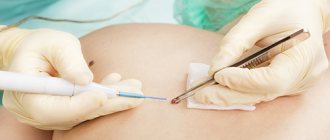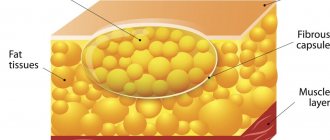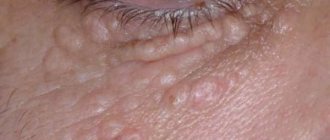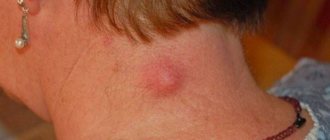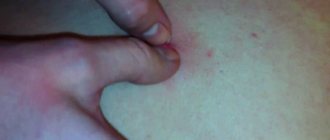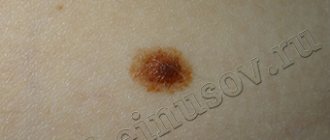Linden is a pathological growth of fat cells that form a benign tumor under the skin or on an internal organ. The latter are removed surgically, and there are several ways to get rid of tumors on the body. One of them is laser removal of wen. This procedure is one of the most effective, fastest and non-traumatic.
Definition
Lipoma is a benign tumor, which is an accumulation of fatty and connective tissue in the subcutaneous tissue. The tumor does not have a clear localization and can form on any part of the body.
Lipoma is characterized by growth, in which it can reach 20 cm or more. With large volumes, the tumor can lead to compression of adjacent vessels and tissues.
Indications
Lipoma removal is carried out only for certain indications:
- tumor diameter exceeds 10 cm;
- compression of tissues , vessels or organs occurs
- location of the tumor on an elongated stalk. Its twisting can cause death of adjacent tissues;
- when palpating the wen, pain ;
- localization in which the formation acts as a cosmetic defect.
Contraindications
Removal of the wen is not possible if there are certain indications. There are two groups of contraindications: absolute and relative.
Absolute contraindications include:
- localization of lipoma near vital vessels and organs;
- concurrent cancer;
- diabetes mellitus at various stages;
- pregnancy;
- immunodeficiency pathologies.
Relative contraindications include:
- diseases caused by the herpes virus;
- acute respiratory inflammation;
- menstruation;
- hypertensive crisis;
- chronic pathologies of internal organs in the acute phase;
- cardiac dysfunction.
Inflammation
Inflammation occurs as a result of tissue trauma, as the body’s response to surgery. The degree of the inflammatory response may vary. The appearance of a red-pink hue and swelling is considered completely acceptable and does not require specific therapy.
However, if there is severe swelling, hyperemia (intense redness), or pain upon palpation, you should immediately consult a doctor, since such conditions may indicate the development of inflammation or the possible addition of a secondary infection. In this case, it is advisable, in addition to local treatment, to prescribe antibacterial and anti-inflammatory drugs.
Preparatory activities
Even though the removal procedure is performed under local anesthesia, the patient still needs to undergo preparation for the operation.
A few days before the procedure, the doctor prescribes a comprehensive examination for the patient, which must include:
- general blood and urine tests
- blood test for syphilis, hepatitis and HIV;
- cardiac examination;
- Ultrasound of the affected area
- X-ray examination , which is prescribed in the case of a voluminous wen located close to the bone tissue.
If the patient has chronic pathologies, then consultation with his attending physician is necessary. At the preparation stage, the anesthesiologist finds out whether the patient is allergic to anesthetics. Based on the data obtained, the necessary painkiller is selected.
See what foods can raise white blood cells after chemotherapy to improve your condition. This article describes what melanoma looks like in its early stages.
Throat cancer: follow the link https://stoprak.info/vidy/golovy-i-shei/gortan/simptomy-zabolevaniya-u-zhenshhin.html symptoms and prognosis in women.
After diagnosis, the patient is introduced to the rules of preparation for surgery:
- when administering general anesthesia, it is necessary to refrain from eating at least 8 hours before removal. If it is planned to perform the operation under local anesthesia, then the last meal should be no less than 2 hours before excision of the wen;
- it is advisable not to smoke several hours before the procedure , since nicotine in the blood increases the risk of complications;
- You should not drink alcohol on the day of surgery or a few days before. This may cause unpredictable effects of anesthesia;
- For surgery, the patient is recommended to come with an assistant who will help him get home. It is not recommended to drive, as concentration and attention may deteriorate after anesthesia.
Side effects
Relapse is a possible side effect after surgery. This occurs when the removal is incomplete, when the capsule remains inside, or when cancer develops. In severe situations, lipomatosis may occur, which develops when the wen is removed incorrectly. In such cases, it is better to contact another surgeon, first making sure of his competence and professionalism. Negative consequences after removal are rare. Complications are also possible when an infection occurs, which occurs with an increase in body temperature and inflammatory processes. Hematoma can also be one of the side effects.
It is recommended that pregnant and breastfeeding women and people with mental disorders refrain from lip surgery.
Process
The procedure for removing a lipoma, if it is small in size, can be performed on an outpatient basis under local anesthesia. In case of large tumor growth, the operation is performed in a hospital, but the patient does not require hospitalization, since the procedure is less traumatic. The operation lasts up to 40 minutes , depending on the volume of the formation. It includes several stages:
- Preparation of the operated field. To do this, the skin in the area of the lipoma and around it is treated with three different antiseptics.
- Providing anesthesia. Since removal is carried out with minimal tissue trauma, they most often resort to local anesthesia using injections. Only the operated area is chipped.
This allows the patient not to feel pain, but at the same time to be conscious and answer questions from the doctor or anesthesiologist. For pain relief, a solution of 2% lidocaine or 1% novocaine is used. If the patient is prone to allergic reactions, then the operated area is injected with novocaine.
- After anesthesia, the surgeon uses a scalpel to make an incision into the skin. Depending on the size of the tumor, the nature of the incision differs. If the formation is small, a longitudinal incision is made along the diameter line, extending no more than 5 mm beyond the edges of the lipoma. In case of extensive growth, a bordering incision is used around the lipoma with an indentation of no more than 1 cm.
- Then, the skin is pulled aside , exposing the wen capsule.
- The capsule is circled with a special instrument in order to destroy the connection between it and adjacent tissues. This will ensure smooth removal of the tumor.
- After this, using a clamp fix the tip of the lipoma and pull it up, and use another tool to pry it from below. Thus, it is possible to remove the capsule along with its contents without damaging its walls.
When removing a bulky tumor, removal is carried out in parts. After exposing it, the capsule is opened and divided into parts, which are removed one after another. Finally, the empty capsule is removed.
- After tumor removal, the vacated cavity is cleaned and undergoes repeated aseptic treatment.
- an electrocoagulator is used throughout the procedure, which cauterizes all vessels.
- drainage is installed in it , which is used as rubber elastic tourniquets. Drainage ensures the drainage of fluid that may accumulate in the wound. As a rule, I remove the drainage for 2–3 days.
- Then internal and external sutures using threads, which subsequently dissolve on their own.
If desired, the patient can examine the removed wen and even photograph it.
If the wen is painful and actively growing, after removal it is sent for histology. This will help to find out the cause of this manifestation and eliminate the risk of malignant degeneration.
Throughout the procedure, a nurse is present in the operating room with a pacemaker and an injection of adrenaline, who will provide first aid in case of complications.
We recommend watching a video of the actual operation:
Rehabilitation
After suturing, the patient is given a little time to recover, after which he goes home. Since the removal is minimally invasive, there is no need for hospital treatment.
The day after the procedure, the patient must visit the clinic again to bandage and monitor wound healing . In the future, dressings will be carried out every other day for 10 or more days, depending on the healing of the wound surface. Dressing in a clinical setting is a mandatory procedure, thanks to which complications can be avoided.
Throughout the healing of the wound, heavy physical exertion should be avoided , as this can cause the sutures to separate. Superficial tissue fusion ends in 1.5–2 weeks.
Complete healing occurs only after 2–3 months . As a rule, in the first 10 days, the patient is given sick leave. After this time, he can already begin to perform his professional duties.
What doctors say about treating thyroid cancer with traditional methods at home. Let's discuss here the symptoms of liver cirrhosis in women at the initial stage.
Is a benign bladder tumor dangerous in men? Here https://stoprak.info/vidy/mochevydelitelnaya-sistema/puzyr/opuxol-u-muzhchin.html expert opinion.
Why does a lump remain after removing the atheroma?
The situation when a lump remains after removal of the atheroma is one of the conditions that can cause a lot of problems for a person. Diagnosis of a tumor of any nature requires immediate medical intervention. In this case, it does not matter at all whether it is benign or not.
In any case, you should not delay seeking qualified help. Even with the most optimistic forecasts, there is always a risk that the tumor will degenerate and become filled with cancer cells. Therefore, when a tumor is detected, doctors insist on its elimination.
In most cases, such operations are successful, but sometimes some remind themselves after time passes.
Atheroma and methods of its removal
Atheroma is one of the types of benign neoplasms that can occur almost throughout the human body.
Most often it is diagnosed in areas of hair growth, and the main reason for such localization is the fact that it develops from an ordinary sebaceous gland. It is these features of the skin that allow you to cleanse the body, remove waste products from it, and participate in its thermoregulation.
In a normal state, a pimple forms at the site where the excretory canal is blocked, which matures over time, cleansing the skin and restoring the functionality of the gland.
However, sometimes, as a result of a blocked sebaceous gland, a rather specific condition occurs, characterized by the accumulation of fatty tissue under the surface of the skin. It is this that is called atheroma, which can cause certain problems to a person.
As a rule, they appear when the tumor becomes inflamed, causing discomfort and even pain. At the same time, unlike an ordinary pimple, atheroma does not mature, but remains in its original inflamed state, which can affect neighboring tissues.
Based on this, its removal in the initial stages is the key to successful treatment and preservation of the patient’s health.
The following methods have shown the greatest effectiveness in combating such manifestations:
- cryodestruction;
- electrocoagulation;
- laser treatment;
- surgical intervention.
All these methods can bring positive results and eliminate atheroma. In most cases, the operation is successful, and the formation is completely neutralized, leaving no trace behind. However, sometimes situations arise when certain difficulties arise after its removal.
Lump after removal of atheroma
The operation to remove atheroma is not classified as complex. Usually the duration of the procedure does not exceed 20-40 minutes. Only in particularly difficult cases, characterized by the development of an inflammatory process, is its removal delayed.
In case of such a development, a surgical method is used, which implies a long recovery period after surgery. One of the possible complications is the formation of a kind of compaction, which forms at the site of the former atheroma and is its secondary manifestation.
There may be several reasons for this phenomenon, ranging from incomplete elimination of the primary manifestations of the disease to genetic deformations of the skin.
The postoperative lump has a fundamentally different structure and is a mobile compaction that does not have specific pigmentation or has some cyanosis.
All other negative signs of secondary atheroma are completely absent, i.e. it does not cause any discomfort at all, and the risk of its degeneration into a malignant neoplasm is minimal. It is only a cosmetic defect that can be completely ignored. However, if the bump remains on the face, it is still better to remove it again.
As a rule, such operations also take place quickly, and if performed well, the atheroma is completely eliminated and does not appear again.
Conclusion
Atheroma is a certain type of benign neoplasm, consisting of adipose tissue and formed as a result of impaired functionality of the sebaceous gland. Moreover, the consequences of its formation can cause a person many problems.
Based on this, the best solution is to remove the tumor at the initial stage. Sometimes situations arise when, some time after the operation, the tumor returns again in the form of a kind of lump.
In turn, it is practically incapable of causing problems to a person or transforming into a cancerous tumor, and its removal is necessary only to ensure a cosmetic effect.
Why does a lump remain after removal of atheroma? Link to main publication
Source: https://1papillom.ru/aterom/pochemu-posle-udaleniya-ateromy-ostalas-shishka.html
Aesthetics
Surgical removal allows you to completely get rid of the lipoma, but this method has a significant drawback - scars. Even with a small incision, scars form after the operation, which do not cause concern when localized on the legs or arms, but cause psychological discomfort when they stand out on the face or neck.
As a rule, after surgery, as the tissue heals, a small round-shaped pit with a fold in the middle forms in place of the removed wen. After about 2 months, the hole levels out, and in its place a slightly convex reddish scar with a glossy surface forms.
Scar after wen removal
Today, such scars respond well to correction using 2 methods:
- Application . It involves the application of various ointments, gels and other products that promote collagen production and smooth out the scar. As a rule, this technique is used immediately after the skin has healed, but it does not always give the desired effect.
- Surgical (Plastic surgery). Correction of scars using plastic surgery can be carried out only 3 months after removal of the lipoma, after the scar is fully formed. Plastic surgery can correct both smoothed and rough voluminous scars.
To carry out this operation, you must contact specialized clinics or centers that have the appropriate license. The cost of such a procedure will depend on the maturity of the scar and its size.
On average, prices for one centimeter of an old scar are about 6 thousand rubles. Removing a newly formed scar using a laser will cost 500 rubles per 1 cm.
Who is indicated for laser lipoma removal?
With the help of a laser, a lipoma can be completely removed, along with the membrane. Only in this case the wen will not form again. First, the patient will have to undergo a comprehensive medical examination, after which the doctor will give an opinion on the possibility of carrying out the procedure.
Indications for laser lipoma removal:
- The tumor tends to grow rapidly.
- The tumor is large.
- The tumor puts pressure on surrounding tissues and nerves, causing pain.
- The tumor provokes functional disorders in other organs.
- The tumor is the cause of a cosmetic defect.
- The tumor disrupts a person’s quality of life; for example, it often becomes inflamed due to constant friction with clothing.
Lipomas are not able to resolve on their own. They are not subject to drug correction, so the only method of getting rid of the tumor is surgery. Laser lipoma removal allows the procedure to be performed quickly and safely for the patient.
Treatment should not be delayed. Although lipomas grow very slowly, their increase in volume is inevitable. If you remove a small tumor, the cut mark will be almost invisible. When it reaches a diameter of 5-10 cm or more, the postoperative scar will be much larger.
People whose tumor is located on visible parts of the body, for example, on the face, scalp or limbs, should first consider the need for laser lipoma removal. Superficial lipomas of the breast, neck, eyelids, and torso lend themselves well to laser correction.
